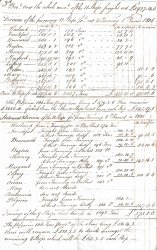
[Napoleonic Wars: Eleven-ship British North Sea Convoy, from Hull to Tønning, Duchy of Schleswig, Denmark (now Tönning, Germany), 1805.] Detailed and lengthy manuscript ‘Statement & Division of 11 Ships Freight to Tonning 1st Round 1805’.
An interesting indicator of the economic impact of the continental blockade in the year of the Battle of Trafalgar. Roger Knight provides an excellent overview of the background to the present document in his ‘Convoys: The British Struggle against Napoleonic Europe and America’ (2022), and in particular the fifth chapter, which deals with North Sea Convoys between 1804 and 1812. Knight states that ‘Convoys from the Nore and the Humber to German ports ensured a flow to the Continent of many re-exported tropical products, including coffee, sugar, tobacco, indigo and raisins and British manufactured exports’, with the Manchester Commercial Society stating that the route was ‘the key through which our manufactures can alone find a passage for the markets of Germany, Switzerland and the borders of Italy.’ The journey described in the present item predates the occupation of Hamburg and the Berlin Decrees of November 1806, after which, as Knight explains, Tonningen, along with Husum, ‘became very busy with “neutral” goods. Hull grew at the expense of London in trade to Northern Europe, as ports in Holland and Germany fell into French hands.’ Since northern Germany and the countries on the Rhine depended on the route for their supplies from England, fortunes were made by merchants willing to take the risk, including Nathan Meyer Rothschild, who was based at the time in Manchester. By 1810 the area had begun to lose its edge and from 1812 there was a economic downturn, ruining some merchants. The present item provides a level of detail not present in Knight’s account. It is 4pp, foolscap 8vo, on a bifolium of laid paper with the watermarked date 1803. Folded three times. Lightly aged, with some wear along folds resulting in minor damage to a handful of words of the text, but in good overall condition. The document concerns a convoy of eleven ships (presumably listed in descending order of tonnage): Harland, Frankfort, Brunswick, Boyton, Mercury, Margaret, Leipzig, Ocean, Mary, Britannia and Pilgrim. (Lloyd’s Register for 1806 provides information about a few possibles plying the ‘Hl Tonin’ route: ‘Boyton S / M Jackson / 213 / Ipswich / Holden & c’, ‘Brunswick Bg / C. Brady / 196 / Hull / Coulsn & c’, ‘Frankfort Bgs / R. Woods / 177 / Hull / Burstl & C.’, ‘Margaret Bg / Medcalf / 195 / Hull / Southern’, ‘Ocean Bg / M. Foster / 143 / Whtby / Blaydes’, ‘Pilgrim S / Harrison / 162 / Hull / Medcalf’.) The first page of the document is headed: ‘1 / Statement & Division of 11 Ships Freight to Tonning 1st Round 1805’, and gives the revenue after deductions of ‘Cha[rge]s. on Goods’, ‘Brokerage’, ‘Commission’ and ‘Extra Average’. The second page continues the ship by ship account of revenue, and is headed: ‘2d. Brought Over [£]3600 4[s] 2[d]’. The third page calculates the equitable division of the revenue (‘The Pilgrim 166 Tons Proportion being £479. 3. 6 there remains £5458. 11 - of which Sum the other 10 Ships must have, each Ship £545. 17. 1’), and is headed ‘Brot. over the whole amot. of the 11 Ships freight out £5937. 14[s]. 6[d]’, with the lower part of the page under the heading ‘Statement & Division of the 11 Ships frt. from Tonning 1st Round in 1805’ (Beside the entries for the Mary and the Britannia, neither of which made the return journey: ‘does not divide’). The fourth page, summarizing the preceding information, is headed ‘4th. / What each Ship must pay & receive for frt. from Tonning’, with the lower part of the page under the heading ‘What each Ship must pay & receive for the voyage out & home’. Accompanying the document is an informative typed analysis (1p, 12mo), apparently dating from the 1990s, with a ‘worked example’, from the data for the Ocean, of ‘the complexities of foreign exchange in the Napoleonic era’. See Image.


